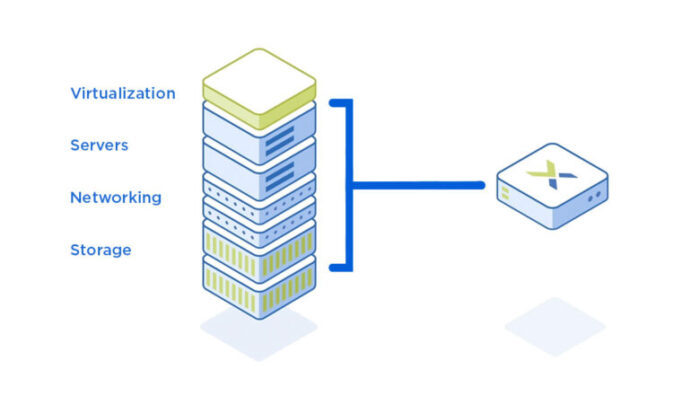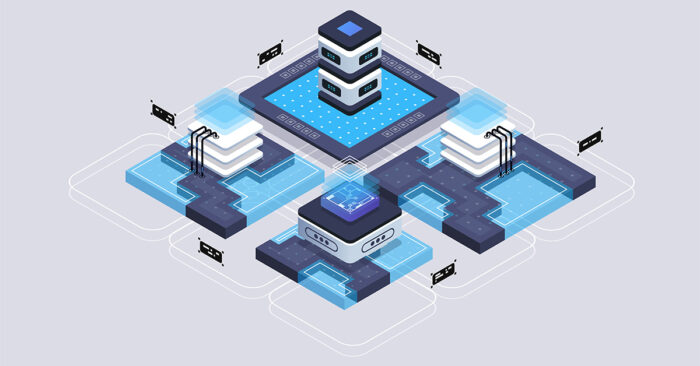
HCI is a software-centric design that combines computation, storage, and virtualization capabilities in a single system, generally x86 hardware. Modern enterprises use data centers to house critical company tasks and data. However, these complex ecosystems can interoperate and offer top performance with proper optimization.
Convergence evolved as a solution to data center heterogeneity. Initially, a single vendor bundled hardware and software from many suppliers into a pre-configured package called converged infrastructure (CI). They later built and manufactured their own bundled, combined computing, storage, and network hardware, dubbed hyper-converged infrastructure (HCI).
Furthermore, converged and hyper-converged systems are made possible by combining virtualization technologies with unified management. Virtualization considers pooled computing, storage, and networking resources, while unified management finds, organizes, divides, and provisions resources to workloads in real-time. This technique is far superior to typical heterogeneous data center infrastructures, which often depend on different management tools.
Today, the combination of virtualized hardware and associated management tooling is frequently treated as a standalone appliance that can function as a single, complete subsystem in the data center or be combined with other HCI appliances to rapidly and easily scale up a hyper-converged infrastructure deployment.
Continue reading to learn more about hyper-converged infrastructure (HCI) basics.

What Exactly Is Hyperconverged Infrastructure (HCI)?
Hyperconverged infrastructure (HCI) is a distributed infrastructure platform that combines servers and storage with intelligent software to make customizable building blocks that replace historical infrastructure that consists of individual servers, storage networks, and storage arrays. It mixes commodity data center hardware with locally connected storage devices (spin disk or flash). A distributed software layer drives it to minimize typical pain points associated with old infrastructure.
How Does HCI Work?
Too frequently, separate pieces of hardware from various manufacturers have been linked with insufficient networking equipment, making provisioning and management difficult with a single tool. The result is usually a jumble of different hardware and software, resulting in confusion, oversights, unnecessary firefighting, and lost effort by IT managers.
The two fundamental principles of hyperconverged infrastructure are integration and management, which originated to tackle two of the most baffling challenges of conventional heterogeneous data centers: inadequate performance and fragmented – difficult – systems administration. HCI aims to provide virtualized scalable computing, storage, and network resources that are all discoverable and manageable from a single platform.

The Top Benefits of Hyperconverged Infrastructure
The following is an outline of the benefits or advantages of using hyper-converged infrastructure for your workloads:
Agility and Flexibility
HCI enables enterprises to operate a variety of workloads, including virtual environments, containers, and cloud-based apps. It allows hybrid and multi-cloud installations and integrates seamlessly with public cloud services. Because of HCI’s versatility, IT teams can swiftly adapt to changing business demands and implement new services.
Scalability
HCI enables enterprises to invisibly grow their infrastructure. Organizations may extend computation and storage capabilities granularly by adding extra nodes, matching their unique needs. This scalability capability enables firms to react to shifting workloads and growth needs while minimizing downtime and interruptions.
Cost Efficiency
When compared to conventional infrastructure options, HCI may deliver cost savings. HCI eliminates the need for separate hardware and administrative tools by combining different components onto a single platform. It also improves resource consumption by lowering overprovisioning and increasing efficiency. Furthermore, HCI’s pay-as-you-grow strategy enables enterprises to start small and expand capabilities progressively as required, reducing upfront capital expenses.
Data Center Consolidation
Change storage arrays, hardware servers, and network connections with a centralized, scalable, cost-effective solution.
Unified Storage
Combine the advantages of dedicated SAN, NAS, and S3 object storage in a single, easy-to-manage solution that is as powerful as reliable storage systems.

Main Use Cases of Hyperconverged Infrastructure
With both hardware and software-based choices on the market, HCI may be a viable option for a wide variety of use cases, especially applications that would not justify the purchase of additional hardware. Watch out for the following HCI use cases:
Virtualization
HCI is rapidly being utilized for virtual servers and desktops with software providers. HCI provides better integration and administration than independent components. Hardware-based HCI is especially beneficial for high-performance applications and the deployment of new hardware.
VDI (virtual desktop infrastructure), on the other hand, benefits from the tight relationship between computing, storage, and the network while being simple to implement and operate. New-build installations benefit from dedicated infrastructure, which makes management simpler than retrofitting HCI onto existing server infrastructure and desktop devices. IT organizations should verify that VDI images can be ported to other providers’ platforms.
SMEs and Remote Offices
Hyper-convergence (HCI) is a low-cost approach for improving remote and branch office IT administration. It removes the requirement for numerous kinds of hardware and is intended for remote management. Companies have market products with declining costs. HCI is appropriate for situations lacking a local IT workforce and may be pre-configured by providers, decreasing the number of builds required. IT support services may employ HCI’s deployment and administration capabilities to remotely manage a smaller firm’s infrastructure remotely, benefiting SMEs and big organizations.
Moreover, SMEs are less sensitive to HCI hardware performance concerns, preferring convenience above performance. Local hyper-converged systems may be connected with cloud-based resources for backup, recovery, and archiving.
Analytics, Machine Learning, and AI
Because of its rapid deployment and scalability by adding nodes, hyper-converged software (HCI) is perfect for analytics, machine learning, and artificial intelligence (AI). By tightly linking IT components, this method enhances performance and dependability. HCI is intended to manage increasing data quantities and newer, compute-intensive advancements such as streaming analytics. It is designed for distributed systems, with nodes handling storage and computing resources to prevent bottlenecks.
Backup and Disaster Recovery
In some respects, HCI for backup is the most basic use case. All required is adding a second hyper-converged system for redundancy and data duplication. HCI is adaptable enough to enable backup and disaster recovery systems on-site, off-site, or in the cloud.

Conclusion
The term “hyperconverged infrastructure” (HCI) refers to a revolutionary approach to data center design that combines computation, storage, and networking into a single platform. It improves scalability, increases robustness, and helps enterprises to construct flexible and efficient IT infrastructures. HCI transforms how enterprises build and manage their data centers by combining virtualization, shared storage, and software-defined solutions.











